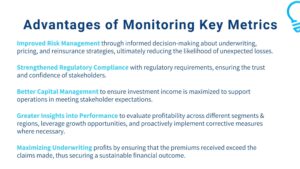In Property and Casualty (P&C) insurance, optimizing financial performance for businesses is a complex and ongoing process that requires a thorough understanding and a constant monitoring system of critical financial metrics. According to NAIC, the P&C industry has seen its fair share of ups and downs, with some data revealing a $22.2 billion underwriting loss in the first half of 2023, the largest since 2011. Another report on Statista shows that in recent years, insurance companies have experienced an increase in incurred losses, resulting in higher payouts compared to previous periods.
However, by analyzing crucial metrics such as the combined ratio, loss ratio, expense ratio, and loss reserve adequacy, insurers can proactively manage some of the industry risks associated with the volatility of the marketplace and hence improve operational efficiency to achieve sustainable growth.
These essential metrics also play a pivotal role in guiding industry experts toward informed decision-making for survival in the face of competition. We explore these metrics in detail and uncover the role of Bright Balance in helping finance teams formulate winning strategies to stay ahead of changing market conditions and emerging trends.

Key Metrics in P&C Insurance
Revenue per policyholder
This represents the average revenue generated by an insurance company from each policyholder within a specific period. This metric is calculated by dividing the total revenue earned by the insurer by the total number of policyholders on the books.
It is a crucial metric for insurers as it helps them evaluate the effectiveness of their pricing strategies, assess customer value, and track revenue fluctuations over time. A higher revenue per policyholder signifies that the insurer is earning more income from each customer, which suggests strong customer loyalty, successful cross-selling, or upselling of additional insurance services. On the other hand, a lower revenue per policyholder may indicate difficulties in attracting and retaining customers or the presence of pricing inefficiencies that require adjustments.
Average cost per claim
The average cost per claim in Property and Casualty (P&C) insurance is the average amount of payouts for each claim reported by policyholders. This metric is calculated by dividing the total claim payouts by the number of claims processed during a specific period, typically a year.
Understanding the average cost per claim is crucial for insurers as it helps them assess their pricing strategies and evaluate their reserves. It also gives them insights into claim severity trends and helps them forecast future claim payouts, enabling them to make informed decisions about underwriting, pricing, and risk management.
Loss Ratio
According to the Michigan Department of Insurance and Financial Services, the loss ratio is a metric used by insurance companies to measure the percentage of the policy premium that has been utilized during the policy term. It takes the total claims that have been reported to the carrier, plus the carrier’s costs to administer the claim handling, divided by the total premiums earned.
It indicates the ratio of losses incurred to premiums earned, which shows how efficient the insurer’s claims management system is. By comparing the loss ratio over different periods and business segments, property and casualty (P&C) insurers can identify patterns in efficiency, evaluate risk exposure, and implement targeted loss mitigation strategies to minimize financial losses in the future
Expense Ratio
The expense ratio is the portion of the premium that is allocated toward covering expenses associated with acquiring, underwriting, and managing insurance and reinsurance policies. It reflects the insurer’s level of operational efficiency by making comparisons between underwriting expenses and earned premiums. Monitoring the expense ratio allows P&C insurers to evaluate the effectiveness of their cost management initiatives and identify opportunities for streamlining operations to continuously enhance overall profitability.
Combined Ratio
Also referred to as the composite/ statutory ratio, is the sum of two ratios (the loss ratio and the expense ratio). A combined ratio below 100% indicates that the insurer’s underwriting operations are profitable, meaning that it is paying out less in claims and expenses than it is earning in premiums.
Conversely, a combined ratio above 100% suggests that the insurer is paying out more in claims and expenses than it is earning in premiums, indicating an underwriting loss. The combined ratio provides a comprehensive measure of underwriting profitability and close monitoring is required for refining practices.
Return on surplus
This is a financial metric that measures an insurer’s profitability compared to its surplus. Surplus, also known as policyholders’ surplus or equity, is the excess of assets over liabilities and serves as a cushion to absorb unexpected losses.
To calculate the Return on Surplus, the net income (after taxes and other expenses) is divided by the surplus. This metric shows how efficiently the insurer is using its surplus to generate profits. A higher Return on Surplus indicates that the insurer is generating more profit relative to the amount of surplus it holds, which is good news for shareholders and policyholders alike.
Insurers therefore aim to maintain a balanced Return on Surplus, representing a thriving business and ensuring adequate reserves to safeguard against potential losses or to support business expansion initiatives.
Loss Reserve Adequacy
Loss reserve refers to the amount of money an insurance company sets aside to cover future claim payments and related expenses. The primary objective of this reserve is to ensure that the funds held by an insurer are enough to cover expected losses from existing claims and potential future claims.
To establish loss reserves, insurance companies use actuarial estimates, historical data, and various statistical models. These reserves are essential for maintaining financial stability and solvency, as they ensure that the insurer can fulfill their obligations to policyholders in the event of claims.
The adequacy of loss reserves is assessed by comparing actual claim payouts with the reserves held by the insurer. If the reserves are not enough to cover the actual claims, it indicates a shortfall in reserve adequacy, which can impact the insurer’s financial stability. This may potentially lead to financial difficulties, resulting in liquidity problems, and regulatory scrutiny.
On the other hand, excessive reserves can unnecessarily tie up capital that could be leveraged in other business opportunities to enhance competitiveness. Therefore, maintaining appropriate loss reserve adequacy is crucial for P&C insurers to meet their obligations to policyholders over time.
Retention ratio
Retention is a key metric that measures the number of clients an insurance company retains from one policy renewal period to the next. In simpler terms, it calculates how many customers choose to remain with their current insurance provider instead of switching to a different insurer when their policy term ends. To determine retention, the number of policies renewed by existing policyholders is compared to the total number of policies up for renewal.
High renewal or retention rates indicate that policyholders are content with their coverage, pricing, and overall experience with the insurer, while low rates may suggest dissatisfaction or the availability of better options elsewhere. For this reason, insurers often focus on retaining existing customers as it can lead to long-term relationships, reduced acquisition costs, and stable revenue streams.
At Bright Balance, our tailored corporate and finance accounting services are designed to support P&C insurers in overcoming the complex challenges posed by evolving business landscapes, including inflation and stringent regulatory demands. We provide a comprehensive range of solutions, from transaction processing and CFO support to detailed Financial Planning & Analysis.
Our Services are customized to suit the needs of insurance companies, offering expert guidance to ensure adaptability in a competitive business environment and aiding in tracking essential metrics for informed decision-making. Additionally, we excel in developing accurate financial projections and resolving revenue recognition challenges for insurance firms.
With a focus on implementing robust revenue recognition policies in alignment with accounting standards such as IFRS 17 and US GAAP, our dedicated team at Bright Balance empowers finance teams in the insurance sector by enhancing their financial reporting capabilities. We also offer training on advanced accounting software to streamline processes, ensuring reliable insights that bolster relationships with stakeholders.
By constantly monitoring and analyzing financial metrics, our team equips decision-makers with valuable insights into business performance and customer trends, giving them a strategic advantage in this competitive industry. Partnering with our team of accounting experts is crucial for thriving in a volatile business environment.
Contact our Dallas office for a complimentary CFO consultation to explore the benefits of Fractional Accounting with Bright Balance today!






